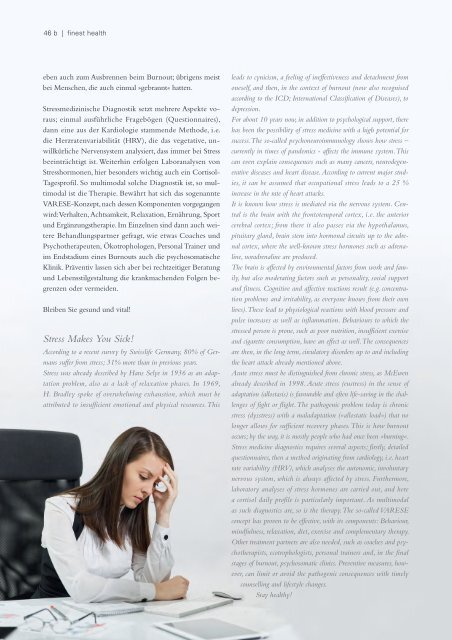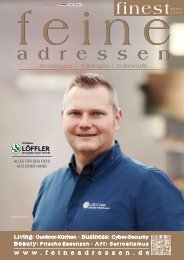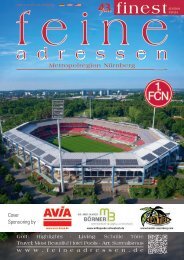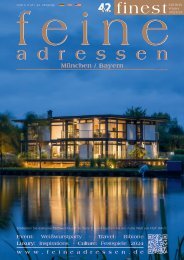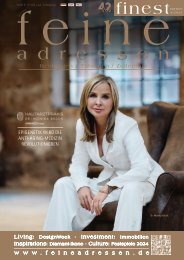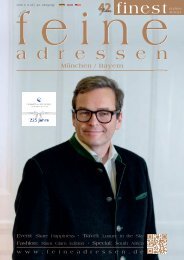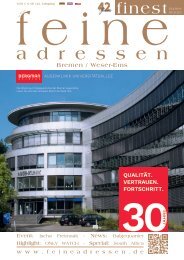»feine adressen – finest« Leipzig 1 21
Interview: Prof. Ulf Schirmer · Culture: Bachfest 2022 · Living: supersalone · Yachting: Cannes Yachting Festival
Interview: Prof. Ulf Schirmer · Culture: Bachfest 2022 · Living: supersalone · Yachting: Cannes Yachting Festival
Erfolgreiche ePaper selbst erstellen
Machen Sie aus Ihren PDF Publikationen ein blätterbares Flipbook mit unserer einzigartigen Google optimierten e-Paper Software.
46 b | finest health<br />
eben auch zum Ausbrennen beim Burnout; übrigens meist<br />
bei Menschen, die auch einmal »gebrannt« hatten.<br />
Stressmedizinische Diagnostik setzt mehrere Aspekte voraus;<br />
einmal ausführliche Fragebögen (Questionnaires),<br />
dann eine aus der Kardiologie stammende Methode, i.e.<br />
die Herzratenvariabilität (HRV), die das vegetative, unwillkürliche<br />
Nervensystem analysiert, dass immer bei Stress<br />
beeinträchtigt ist. Weiterhin erfolgen Laboranalysen von<br />
Stresshormonen, hier besonders wichtig auch ein Cortisol-<br />
Tagesprofil. So multimodal solche Diagnostik ist, so multimodal<br />
ist die Therapie. Bewährt hat sich das sogenannte<br />
VARESE-Konzept, nach dessen Komponenten vorgegangen<br />
wird: Verhalten, Achtsamkeit, Relaxation, Ernährung, Sport<br />
und Ergänzungstherapie. Im Einzelnen sind dann auch weitere<br />
Behandlungspartner gefragt, wie etwas Coaches und<br />
Psychotherapeuten, Ökotrophologen, Personal Trainer und<br />
im Endstadium eines Burnouts auch die psychosomatische<br />
Klinik. Präventiv lassen sich aber bei rechtzeitiger Beratung<br />
und Lebensstilgestaltung die krankmachenden Folgen begrenzen<br />
oder vermeiden.<br />
Bleiben Sie gesund und vital!<br />
Stress Makes You Sick!<br />
According to a recent survey by Swisslife Germany, 80% of Germans<br />
suffer from stress; 31% more than in previous years.<br />
Stress was already described by Hans Selye in 1936 as an adaptation<br />
problem, also as a lack of relaxation phases. In 1969,<br />
H. Bradley spoke of overwhelming exhaustion, which must be<br />
attributed to insufficient emotional and physical resources. This<br />
leads to cynicism, a feeling of ineffectiveness and detachment from<br />
oneself, and then, in the context of burnout (now also recognised<br />
according to the ICD; International Classification of Diseases), to<br />
depression.<br />
For about 10 years now, in addition to psychological support, there<br />
has been the possibility of stress medicine with a high potential for<br />
success. The so-called psychoneuroimmunology shows how stress <strong>–</strong><br />
currently in times of pandemics - affects the immune system. This<br />
can even explain consequences such as many cancers, neurodegenerative<br />
diseases and heart disease. According to current major studies,<br />
it can be assumed that occupational stress leads to a 25 %<br />
increase in the rate of heart attacks.<br />
It is known how stress is mediated via the nervous system. Central<br />
is the brain with the frontotemporal cortex, i.e. the anterior<br />
cerebral cortex; from there it also passes via the hypothalamus,<br />
pituitary gland, brain stem into hormonal circuits up to the adrenal<br />
cortex, where the well-known stress hormones such as adrenaline,<br />
noradrenaline are produced.<br />
The brain is affected by environmental factors from work and family,<br />
but also moderating factors such as personality, social support<br />
and fitness. Cognitive and affective reactions result (e.g. concentration<br />
problems and irritability, as everyone knows from their own<br />
lives). These lead to physiological reactions with blood pressure and<br />
pulse increases as well as inflammation. Behaviours to which the<br />
stressed person is prone, such as poor nutrition, insufficient exercise<br />
and cigarette consumption, have an effect as well. The consequences<br />
are then, in the long term, circulatory disorders up to and including<br />
the heart attack already mentioned above.<br />
Acute stress must be distinguished from chronic stress, as McEwen<br />
already described in 1998. Acute stress (eustress) in the sense of<br />
adaptation (allostasis) is favourable and often life-saving in the challenges<br />
of fight or flight. The pathogenic problem today is chronic<br />
stress (dysstress) with a maladaptation (»allostatic load«) that no<br />
longer allows for sufficient recovery phases. This is how burnout<br />
occurs; by the way, it is mostly people who had once been »burning«.<br />
Stress medicine diagnostics requires several aspects; firstly, detailed<br />
questionnaires, then a method originating from cardiology, i.e. heart<br />
rate variability (HRV), which analyses the autonomic, involuntary<br />
nervous system, which is always affected by stress. Furthermore,<br />
laboratory analyses of stress hormones are carried out, and here<br />
a cortisol daily profile is particularly important. As multimodal<br />
as such diagnostics are, so is the therapy. The so-called VARESE<br />
concept has proven to be effective, with its components: Behaviour,<br />
mindfulness, relaxation, diet, exercise and complementary therapy.<br />
Other treatment partners are also needed, such as coaches and psychotherapists,<br />
ecotrophologists, personal trainers and, in the final<br />
stages of burnout, psychosomatic clinics. Preventive measures, however,<br />
can limit or avoid the pathogenic consequences with timely<br />
counselling and lifestyle changes.<br />
Stay healthy!


